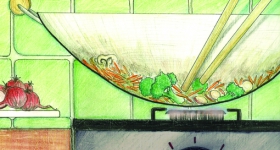“No rice, please.” I keep hearing this disturbing sentence
from Asian American friends. Many are fighting the
battle of the bulge and some are convinced that rice is the enemy. Or maybe
it’s gluten. Wait, was it sugar, or eating late at night? Despite an endless
stream of nutrition information, we seem more confused than ever about what to eat
to stay fit and feel good. As for myself, a rice-less future is not one I want to participate in! To add to the problem, the food and pharmaceutical
industries often pay nutritionists as spokespeople, so sorting out truth
from ads can be near impossible. The result: voodoo attempts at weight
loss.
For help, I reached out to Professor Marion Nestle, a UC
Berkeley grad and one of America’s leading experts on health, nutrition and
weight loss. She is the author of the popular blog Food Politics and a professor at New
York University. Her newest book is Why Calories Count: From Science to Politics, and I hoped reading it would help me
understand whether one of my favorite foods, rice, was leading to my eventual ruin.
I can’t say that I fully understood calories until this book:
they are “units of heat energy,” but what does that really mean for a living,
breathing body? What about so-called “good calories” and “bad calories”? How
many calories do we really eat in the real world?
The book starts with a fascinating history of scientists
attempting to measure calories and understand their effects on the body,
particularly if you take in too much or too little. These extremes have special
relevance to Asian Americans, whom studies
have found are facing increased health problems the longer we are in America,
and hence eating American food. From a caloric standpoint, most of us have gone
from consuming zero to 60 in a relatively short period of time. The appearance (and
stereotype) of thinness is deceptive for Asian Americans, many of whom still
suffer from hypertension or diabetes as metabolisms struggle to adjust to new
diets.
“The rapid increase in calories, increase in fat, increase
in different kinds of food patterns, higher density foods, is what the body
isn’t used to and causes metabolic problems that result in disease,” says
Nestle. “The body doesn’t like to have too many calories for what it needs.
Metabolism is set up to burn all the calories that you eat, and not to store
many of them. ”
But calories are hard to understand viscerally -- even Nestle
admits it’s hard for her to gauge calorie counts in restaurant foods, which are
often are loaded with fats, sugars and other yummy calorie-loaders. Researchers
like Dr. David Kessler, author of The
End of Overeating, argue that the fat, salt and sugar in processed foods
actually rewire our brain to want and
need more of them. So don’t feel bad if you have no idea how many calories are
in a Twinkie or frozen enchilada. As Americans eat more processed foods,
research indicates that our diet-related health problems are increasing.
This way of eating is now being exported around the world. According to Nestle,
“As it’s becoming apparent that the major American and multinational food
companies aren’t making money in the US anymore, they are pushing junk foods on
India and China and other places. We are exporting obesity and its
consequences.”
For foods a little closer to nature, like rice, it all comes
down to quantity. “We know, from historical epidemiology, that rice-based diets
were healthy for the populations consuming it. But they weren’t eating too much
of it,” says Nestle. This made me think about food-specific bowls and plates in many
Asian cuisines. Take the single-serving Chinese or Japanese rice bowl. It’s a
standard size. You know when you’re eating one, or three. Its general size
hasn’t changed in hundreds, or thousands of years. Same with the flat metal
bowls some Indian dishes are served in. Might this be one secret to calorie
control we should continue to use in America? For me, when food is served in a
trough, I tend to eat like a pig.
Good news for Asian traditional foods: Marion Nestle
considers them great. “There are lots of examples of best possible diets, and
Asian diets are one of them: lots of rice and vegetables, a small amount of
meat, little sugar. Just eat that,” she says. By controlling quantity, there’s
more latitude to eat fun foods and not worry about it.
Finally, Nestle’s book pivots back to politics. The way
society interprets what we should consume is not neutral, and through all her
books (she’s published seven) she touches on the political aspects of science,
nutrition and food. Which lobbyist paid whom? Why does this regulation make
sense, and that one doesn’t? These political players and variables ultimately
affect the food we eat and disturbingly, the decisions we make (especially if
price or perception are involved, which of course they are in something as
intimate as food). I like that Nestle empowers readers to understand larger
social forces behind the food they’re eating, and then get right in and try to
change them. You’ll need a bowl of rice for energy.









Comments